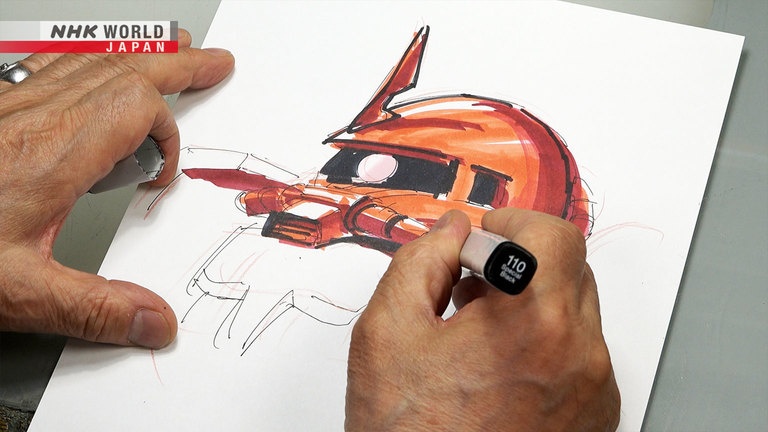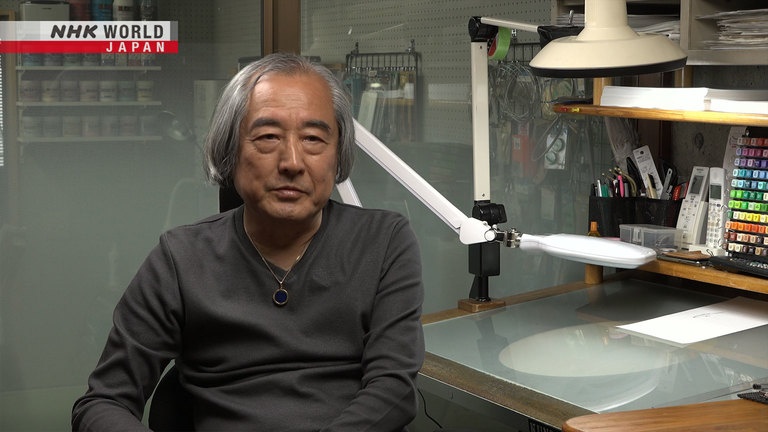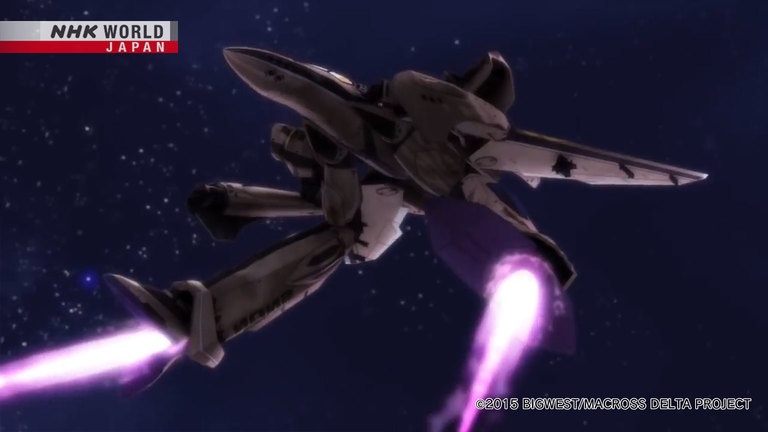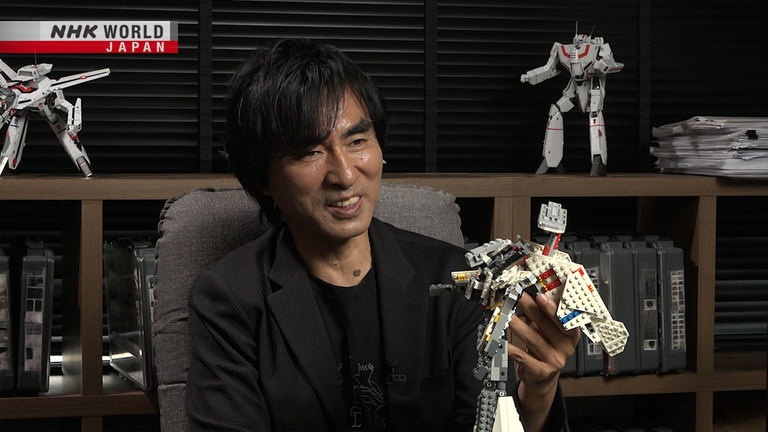Anime Encyclopedia: MECHANICAL DESIGNER
ANIME MANGA EXPLOSION dives into the world of Japanese anime and manga, both of which have gained an immense global following. In this episode, we feature the mechanical designers responsible for some of Japan's most famous anime and manga robots, including Okawara Kunio, creator of Gundam, and Kawamori Shoji, who built the elaborate mechas of Macross. How do they continue to come up with innovative designs for over 40 years? Get a glimpse into their creative process through rare drawings and prototype models.




Transcript
ANIME MANGA EXPLOSION.
Aerial, launching!
Mecha anime is one of Japan's most well-known pop-culture exports.
A variety of different robots have been created over the years.
Designing those robots is a difficult task that requires a special type of creator.
They are known as mechanical designers.
Mechanical designers are experts at designing machines like robots and vehicles,
including highly-detailed internal parts.
Okawara Kunio is Japan's first-ever mechanical designer.
The legendary creator is credited in nearly 100 anime series,
including Mobile Suit Gundam and the Time Bokan series.
Okawara's commitment to his vision led to his masterpiece, Gundam.
It's just cool.
The robots are like armor.
We'll also feature another legend known for his innovative transforming robots: Kawamori Shoji.
He specializes in robots that transform or combine, like those in the Macross and Aquarion series.
Kawamori's method of designing is very unique.
Ideally, a designer makes brand-new concepts
that can change society.
This time, we're taking an in-depth look at these two creators —
and the history of Japanese mecha anime they helped create.
This thing's on!
Mobile Suit Gundam began broadcast in 1979.
The robot weapons, called "mobile suits," became a sensation across Japan,
and the anime is now one of Japan's biggest series.
The mechanical designer behind the robots is Okawara Kunio.
We received special permission to film inside his workplace.
Countless famous robots were created on this desk with over 200 color pens and brushes.
Above the desk is a seemingly random pile of valuable designs.
I would use B4-sized paper
for a robot like this.
I use a 0.5mm pen to get sharp lines.
Great for submission.
The first anime Okawara was involved with was Gatchaman, which aired from 1972.
Okawara was assigned to work on backgrounds as a member of the art staff.
There weren't many machine fans
in the art staff.
So, I asked if I could work
on machine designs.
That's how my career started.
Okawara created spec sheets for Gatchaman's secondary machines.
But his job wasn't only about machine design.
On the screen, every part is acting,
including the small screws.
My job is to convey the shapes
to the animators.
Mechanical designers are responsible
for the work's worldview.
People don't understand
how much work it takes.
This is a laboratory on the ocean floor.
Okawara instructed animators that the entrance would be under the laboratory with space for a submarine to dock.
He created machine designs that would be easy for animators to replicate.
I can create the shapes
but never learned how to animate,
so I rely heavily on the animators.
It's always so exciting
to see the machines come to life.
From episode four, Okawara was credited as mechanical designer - the first ever in Japan.
Okawara's work on Gatchaman led to a steady stream of mechanical design job offers.
At the peak of the mecha anime boom, he simultaneously worked on four different anime episodes a week.
I only had two days for each design.
I would finish the design in my head
while we discussed the details.
Then I output my vision,
which doesn't take too long to finish.
No matter how busy work got, Okawara was always aware of the audience.
This is a robot design from Yatterman.
Fans loved the unique enemy robots in each episode.
Based on a washing machine, it attacks with a propeller-like part.
Since the audience was mostly children,
I aimed for easy-to-understand designs.
Focusing on realism just bores kids,
so we created fun and silly robots.
For Okawara, one of the biggest goals when designing machines was how to make them appeal to younger viewers.
There's another process that Okawara considers indispensable.
That happens here, in a room that looks like a small local factory.
This is a milling machine used to cut metal and wood.
This is a machine for drilling holes.
This is a laser cutter.
He also has a lot of screws.
There's a lot of transforming
and combining pieces,
which is easy to build in your head.
I come here to create actual prototypes
to determine if the design makes sense.
This is one toy robot that came from an anime.
In the 70s and 80s, toy robots were huge sellers, so toy manufacturers ended up sponsoring mecha anime.
Therefore, to raise funds for an anime project, designing robots that could be developed as toys was essential.
When I worked with Sunrise,
the company's head of planning and I
pitched ideas to sponsors.
Once we got the okay,
production would start immediately.
I always attended presentations
because approval meant everything.
Okawara would show sponsors his handmade prototypes.
Here's one the creator made in just four days.
It's easy to see Okawara's influence on the final product.
The goal was to see
if I could make a robot belly.
It transforms for battle like this.
I thought it would be a fun toy.
There's no need to use much effort,
but I enjoy the process.
For Okawara, being a mechanical designer meant designing robots for anime and toy manufacturers.
Okawara's creativity has captured the attention of fans worldwide.
In 2023, a solo exhibition was held in Hong Kong,
celebrating Okawara's 50th anniversary as a Mechanical designer.
The exhibition featured over 300 design images and illustrations from 34 anime series Okawara worked on.
His robot designs are very popular in China.
This is his fourth solo exhibition.
For any anime fan, an Okawara-designed robot is special.
Fans lined up to get their favorite Mechanical designer's autograph.
Yes, I am a fan.
Even if when they released Gundam SEED, I went out and actually tried to watch all of them,
even if I don't know to speak Japanese just to look at the animation and the Gundam designs.
It was really, really cool.
It's amazing how he combines
animals and robots so effortlessly.
I love how the designs
are both simple and realistic.
We visited the home of one of Okawara's Hong Kong fans.
Gundam@EFSF works in education.
He has a room just for anime collectibles.
More than 1,000 figures and plastic models from Gundam line the shelves.
And one of his newest treasures?
A book that Okawara signed during the latest event in Hong Kong.
There were various anime magazines
available in Hong Kong.
That's where I learned
about Okawara-san.
He is an amazingly talented individual
who can work with all kinds of designs.
His favorite Okawara robot is this classic model.
It's the first Gundam that Amuro Ray rides.
The overall design has a sophistication
that I've loved since I was young.
Amuro! Here I go!
Mobile Suit Gundam is a landmark series that put Japanese mecha anime on the map.
Okawara, who had been working freelance, joined the production team from the start as main machine designer.
For "Gundam," animation director Yasuhiko
showed me a powered armor
from Heinlein's "Starship Troopers."
He wanted it to be the main machine.
It was an illustration from a popular science fiction novel.
The animation director was interested in the suit-like machine design.
How did Okawara respond?
The audience would be children,
so I thought the design would have
little impact during the showcase.
Okawara went with a samurai helmet-inspired design to appeal to younger viewers.
In middle school, I wore real armor
during a Soma Nomaoi festival.
It was so cool.
Since robots are kind of like armor,
I got a lot of inspiration from that.
Okawara designed Gundam to be a bold adaptation of samurai armor.
This is an early draft.
The head of the robot had samurai-like features.
On the back were two katana-inspired beam sabers.
The body was designed to look like formal samurai attire called "kamishimo."
And for the legs, Okawara went with a new design not found in traditional mecha anime.
I wanted to get away from
square and circular column designs.
So I added human-like calves.
This is the final draft of Gundam's design proposal.
Animation director Yasuhiko brushed up Okawara's original design.
The engrossing story and exciting mechanical design made Mobile Suit Gundam a huge hit.
Gundam's popularity now spans the globe, with actual life-sized robots being built!
The enemy robots are also reason for the series' success.
We're in 2023, and the design
is still considered trendy.
I have a feeling it might be hard
to recreate today.
Among enemy robots, Zaku was one of the most popular.
It holds a special place in Okawara's heart.
Main robots have too many restrictions.
The design isn't finished
until everyone has their say,
including the director,
production team, and sponsors.
That's why I have so much more fun
working with enemy designs.
There was no plan to turn enemy robots into toys, so Okawara had much more freedom.
For Zaku, the only requirement from the director was for the robot to be a cyclops.
Okawara designed the head to resemble a gas mask.
He also attached visible pipes to the face, waist, and legs.
Pipes protruding out of the robot
make it extremely vulnerable in battle.
But the look completely changes
with or without them.
Anime is fiction, and in the end,
it needs to be appealing to the viewer.
Creating out-of-the-box designs is
one of the best parts of being a creator.
In April 1979, the robots designed by Okawara began to move on the TV screen.
Episode one surprised me
when Zaku entered the colony.
It went beyond my expectations.
I didn't care if it was a hit or not.
We created something amazing,
and that's all I needed.
Gundam!
Forty-three years since Gundam first aired.
The latest in the series is Mobile Suit Gundam: The Witch from Mercury.
The main robot contains circuits that glow with eye-popping reds and blues,
emphasizing that it uses technology not found in other robots in the series.
Gundam Aerial's design was decided through an open competition.
The winner was 42-year-old illustrator JNTHED.
Okawara's first design has since been followed by a new generation of mechanical designers
that continue to build on Gundam's popularity.
Targets confirmed as hostile.
All weapons free. Formation Erebus!
Macross has been popular in Japan for over 40 years, with seven TV series and ten feature films.
The iconic machine of the series is Valkyrie, a variable fighter with three forms.
It transforms into an aircraft for fighter mode,
a humanoid robot for battroid mode,
and an intermediate mode called Gerwalk.
This brand-new concept had each machine transform depending on the situation.
Fans around the world couldn't get enough of the design gimmicks.
The YF-19 and the YF-21 are definitely sort of the standouts for me.
I mean, of the plane mode and the robot mode. It's just...
had a sort of futuristic feel while still maintaining something that could be somewhat plausible in the real world.
One of their sort of key, legacy franchises...
You can't appreciate other mecha anime that was around at the time or came since without appreciating Macross.
You know, except so many, with like the transforming mecha, it kind of broke multiple boundaries.
The mastermind behind Macross' beloved machines is Kawamori Shoji.
Kawamori has designed machines for multiple anime series, and directed episodes of Macross and Aquarion.
His designs are characterized by robots that combine and transform.
Kawamori's unique, freeform style earned him the nickname "The Wizard of Mechanical Transformation."
Outside of anime, he is one of the theme concept producers for World Expo 2025 Osaka, Kansai.
This is where Kawamori works.
The table is covered by a variety of toy building blocks.
He works on a low desk over a tatami mat.
I use toy building blocks
when creating transformable machines.
The assembled parts are fragile.
I work close to the ground
in case I drop them.
It's like my hands think for me.
My brain and hands split the work.
Kawamori showed us a toy block prototype.
This is a prototype of Valkyrie's YF-30 model, made by Kawamori.
He strives to create aerodynamic designs that could realistically fly.
I studied mechanical engineering
and wanted to build real airplanes,
cars, and rockets.
Even in fiction,
that has stayed with me.
And the biggest draw of using toy building blocks is that they can transform, just like in the anime!
First, the jet nozzles become legs.
Then, arms pop out from under the wings.
This is basically a Gerwalk.
Gerwalk is a plane and machine hybrid that hovers in battle.
Then, the humanoid transformation.
Kawamori's focus on realism is seen in every detail.
This part that sticks out
is found on real fighter planes.
Using parts found on a real fighter jet, Kawamori figures out ways to reassemble and transform the machine.
Finally, the wings are folded back.
This is how it looks.
This is how Kawamori is able to simulate transformations using toy building blocks.
Although the anime is fiction and imagination plays a big part in the process,
Kawamori's mechanical designs always pursue a physically realistic look.
For me, a good design has function.
Ideally, it should be original, too.
Innovation is what makes good design.
Kawamori's pursuit of both style and functional beauty helped form the unique designs that fans adore.
He began using toy building blocks during the production of the third entry in the Macross series.
He has carefully preserved past prototypes.
The Macross series came from Kawamori and his associates' desire to create a new type of hero machine.
While in university, Kawamori joined Studio Nue, a team focused on science fiction works.
His abilities were quickly recognized, and he became a professional designer while still a student.
During one planning meeting with studio members,
they discussed developing a new machine to replace humanoid robots.
At the time, Mobile Suit Gundam was all the rage.
Kawamori and the team had to come up with something new.
It's hard to differentiate
between humanoid robots
because there are so many.
So, we decided to make something
to replace main humanoid robots.
An idea came to Kawamori one year later while he was on vacation skiing.
I thought about how I bend my knees
to control movement as I ski.
It sounded like a good design idea.
I could make a machine with knees
that bend forward and backward.
This resulted in the reverse-jointed Gerwalk.
It was a brand-new design that differed from a typical humanoid robot.
The team immediately put together a toy proposal, but the manufacturer was not impressed.
The presentation went horribly.
They were only interested in humanoid
designs. I was so frustrated.
To get the project approved, Kawamori and his team proposed a machine that could transform from a plane into a humanoid robot.
Gerwalk was part of the gimmick.
From a physics point of view,
large humanoid robots made no sense.
We decided to go all in
and make the enemies huge, too.
We laughed all night
coming up with "MACROSS."
And so Macross and the variable fighter Valkyrie were born.
At the time, the Valkyrie had caught the attention of a certain creator.
That creator was Okawara.
Anybody can come up with a battle robot,
but the Gerwalk style felt so new.
I love the design.
Since we were working on an original,
we wanted to focus on functionality.
And it paid off.
I learned you'll find breakthroughs
if you don't give up.
Thanks to these talented mechanical designers, the popularity of mecha anime has grown worldwide.
Although production numbers have decreased,
Okawara and Kawamori remain hopeful and have advice for future designers.
In my case,
it was all about the people I met.
They gave me this life,
so meeting the right people is key.
I hope other mechanical designers
can find that chance
and create their masterpieces.
I want them to show me
something I've never seen before.
I want to be like,
"I never thought of that!"
After all, being a designer
is about creating brand-new concepts
that can change society.